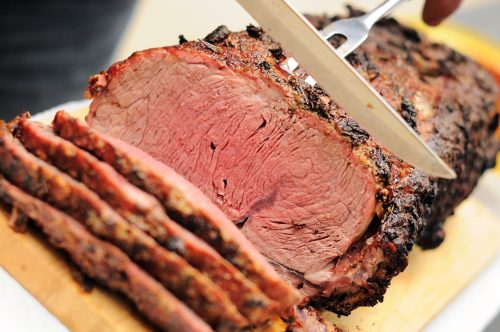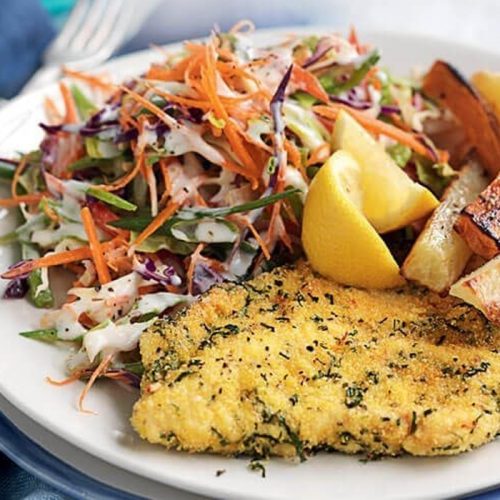
Here’s everything you need to know to make a healthy roast dinner.
Basic roasting rules
Whatever type of meat you plan to roast, follow these simple rules:
- Always weigh the roast before cooking to ensure the correct cooking time, but remember that cooking times are meant only as a general guide. A long thin piece of meat will take less time to cook than a thick round one of the same weight.
- Bring meat to room temperature before cooking; remove it from the fridge about 20 minutes before you plan to cook it.
- Use a heavy-duty roasting dish, large enough to allow your roast to become evenly cooked and browned.
- Use a roasting rack in the baking dish. This helps get good circulation of heat around the meat and allows the fat from the meat to be drained away, making your roast healthier.
- Always preheat your oven to the required temperature – this may take 15 minutes.
- Check for edges of the roast that may catch and cover with foil to prevent burning.
- If you don’t have a thermometer to check if meat is cooked, push a skewer right into the middle of a joint. If the juices run clear, the meat is thoroughly cooked; if they run pink, the meat is medium; if bloody, it’s rare or under-cooked. Remember: chicken must always be cooked thoroughly.
Preparing a chicken for roasting
- Remove any giblets from the chicken cavity. Rinse the chicken out under cold water. Make sure the skin of the chicken is dry by patting with kitchen paper.
- Place the chicken on a roasting rack in a heavy-duty roasting dish. Fill the cavity with fresh herbs, orange or lemon slices and some unpeeled garlic cloves or onion slices – these will give the chicken meat a wonderful flavour and keep it moist. Tie the legs of the chicken together with kitchen string.
- Season the chicken with pepper and a little olive oil spray. The chicken is ready for roasting – allow 20 minutes per 500g, plus 20 minutes at 190°C.
Basting the roast
Basting is the technique when the roast is taken out of the oven during its cooking time and the juices and melted fat that have been produced are spooned over the meat. Basting is usually carried out once or twice during the cooking time. Basting prevents the meat drying out and keeps it moist.
Resting meat
Resting meat after cooking – setting it aside for a time out of the oven – is important. This allows the fibres of the meat to relax. The juices in meat expand during roasting and shrink as the meat cools, so the joint deflates and the fibres consolidate – in other words, the juices settle. The meat becomes firmer and so easier to carve. If you try to carve a roast straight from the oven, the slices will be ragged and steam from the hot juices can cause burning. You may also find a lot of juice runs out of the meat. As a general rule, large joints weighing more than 2kg should be covered in foil and rested for 20-30 minutes; small roasts need 10-15 minutes and can be rested uncovered.
Carving tips
Whichever type of meat you are carving, here are a few rules to make it easier.
- A decent-sized, really sharp knife is essential.
- Always place the joint on a firm, flat, non-slip surface such as a board.
- Remove any string from the cooked joint, which can get in the way as you carve.
- Carve the meat across the grain to ensure tenderness. The grain is the meat fibres that run along the length of the joint. This usually means cutting at a right angle to the bone.
Simple ways to make healthy roasts
- Choose less fatty cuts of meat for roasting and trim off any visible fat, see our guide to buying beef. For beef: fillet, rib-eye, sirloin and standing rib are leaner options which can be roasted at high temperatures – 190-200°C.
- Pork tenderloin for roast pork is a healthier option. It is quick to cook as there is no bone, and is delicious seasoned with ginger, herbs and garlic.
- Season meats with freshly chopped herbs, and finely chopped garlic. Whole grain mustard adds extra flavour and helps bind ingredients together.
- Use a fine olive oil spray to season the meat. This helps you use less oil.
- With all roasts, once cooked, discard the skin and enjoy the tender meat.
- Make your gravy using only a small amount of meat juices combined with lean stock (see recipe).
- Traditionally roast vegetables are added to the pan of the roast and cooked in the meat juices. For less fatty vegetables, cut into large, even-sized chunks, blanch in boiling water and thoroughly drain in a colander. Place in a large separate roasting dish, spray with olive oil, season with pepper and roast until tender.
Recipe ideas
Lemon and garlic roasted chicken
Onion and date herby stuffing
Healthy roast lamb
Crispy low-fat roast potatoes
Gravy
www.healthyfood.com










